Insight into the Structure Evolution and Performance Optimization of Bi0.5Na0.5TiO3-Based Ceramics for Energy Storage Application
Abstract
:1. Introduction
2. Experimental Procedure
2.1. Samples Preparation
2.2. Structure and Properties Characterization
3. Results and Discussion
3.1. Structure of (1 − x) BNT-x SMN Ceramics
3.2. Dielectric Properties of (1 − x) BNT-x SMN Ceramics
3.3. Ferroelectric Properties of (1 − x) BNT-x SMN Ceramics
4. Conclusions
Author Contributions
Funding
Institutional Review Board Statement
Informed Consent Statement
Data Availability Statement
Conflicts of Interest
References
- Kang, R.R.; Wang, Z.P.; Yang, W.J.; Zhao, Y.Y.; Zhang, L.X.; Lou, X.J. Enhanced energy storage performance of Bi0.5Na0.5TiO3-based ceramics via grain tuning and relaxor construction. Chem. Eng. J. 2023, 455, 140924. [Google Scholar] [CrossRef]
- Tan, D.Q. Review of polymer-based nanodielectric exploration and film scale-up for advanced capacitors. Adv. Funct. Mater. 2020, 30, 1808567. [Google Scholar] [CrossRef]
- Yuan, Q.B.; Zhan, S.L.; Li, Y.X.; Wang, Y.F.; Yang, H.B.; Zhou, J.J.; Li, Z.; Jing, H.M.; Yao, F.Z.; Lei, T. Toward high-end lead-free ceramics for energy storage: Na0.5Bi0.5TiO3-based relaxor ferroelectrics with simultaneously enhanced energy density and efficiency. Mater. Today Energy 2023, 31, 101202. [Google Scholar] [CrossRef]
- Chen, Z.M.; Pu, Y.P.; Ning, Y.T.; Hui, Y.T.; Wu, C.H.; Zhang, L.; Zhang, X.Q.; Wang, B. Prominent energy storage density and efficiency of Na0.5Bi0.5TiO3-based ceramics via multiscale amelioration strategy. J. Am. Ceram. Soc. 2024, 107, 2360–2370. [Google Scholar] [CrossRef]
- Wang, W.; Zhang, L.Y.; Shi, W.J.; Yang, Y.L.; Alikin, D.; Shur, V.; Lou, Z.H.; Wang, D.; Zhang, A.M.; Gao, J.H.; et al. Enhanced energy storage properties in lead-free (Na0.5Bi0.5)0.7Sr0.3TiO3-based relaxor ferroelectric ceramics through a cooperative optimization strategy. ACS Appl. Mater. Interfaces 2023, 15, 6990–7001. [Google Scholar] [CrossRef]
- Qiao, X.S.; Wu, D.; Zhang, F.D.; Chen, B.; Ren, X.D.; Liang, P.F.; Du, H.L.; Chao, X.L.; Yang, Z.P. Bi0.5Na0.5TiO3-based relaxor ferroelectric ceramic with large energy density and high efficiency under a moderate electric field. J. Mater. Chem. C 2019, 7, 10514–10520. [Google Scholar] [CrossRef]
- Wang, M.Q.; Lin, Y.; Chen, M.; Zhang, M.; Yuan, Q.B.; Yang, H.B. High energy storage efficiency and excellent recoverable energy storage density realized in 0.65Bi0.5Na0.5TiO3-0.35BaTiO3-SrZr0.5Ti0.5O3 ceramics. J. Mater. Chem. C 2023, 11, 6407–6416. [Google Scholar] [CrossRef]
- Jiao, Y.; Song, S.M.; Chen, F.K.; Zeng, X.Y.; Wang, X.R.; Song, C.L.; Liu, G.; Yan, Y. Energy storage performance of 0.55Bi0.5Na0.5TiO3-0.45SrTiO3 ceramics doped with lanthanide elements (Ln = La, Nd, Dy, Sm) using a viscous polymer processing route. Ceram. Int. 2022, 48, 10885–10894. [Google Scholar] [CrossRef]
- Wu, L.L.; Zhang, J.J.; Du, H.W.; Chen, J.F.; Yu, H.N.; Liu, Y.P.; Wang, J.Y.; Zhou, Y.; Yao, Y.X.; Zhai, J.W. Chemical nature of the enhanced energy storage in A-site defect engineered Bi0.5Na0.5TiO3-based relaxor ferroelectrics. J. Alloys Compd. 2022, 905, 164183. [Google Scholar] [CrossRef]
- Shen, Y.H.; Wu, L.K.; Zhao, J.H.; Liu, J.J.; Tang, L.M.; Chen, X.Q.; Li, H.H.; Su, Z.; Zhang, Y.; Zhai, J.W.; et al. Constructing novel binary Bi0.5Na0.5TiO3-based composite ceramics for excellent energy storage performances via defect engineering. Chem. Eng. J. 2022, 439, 135762. [Google Scholar] [CrossRef]
- Jiang, Z.H.; Yang, H.C.; Cao, L.; Yang, Z.Y.; Yuan, Y.; Li, E.Z. Enhanced breakdown strength and energy storage density of lead-free Bi0.5Na0.5TiO3-based ceramic by reducing the oxygen vacancy concentration. Chem. Eng. J. 2021, 414, 128921. [Google Scholar] [CrossRef]
- Zhang, Y.; Xie, A.W.; Fu, J.; Jiang, X.W.; Li, T.Y.; Zhou, C.; Zuo, R.Z. Superior energy-storage properties in Bi0.5Na0.5TiO3-based lead-free ceramics via simultaneously manipulating multiscale structure and field-induced structure transition. ACS Appl. Mater. Interfaces 2022, 14, 40043–40051. [Google Scholar] [CrossRef] [PubMed]
- Jiang, Z.H.; Yang, Z.Y.; Yuan, Y.; Tang, B.; Zhang, S.R. High energy storage properties and dielectric temperature stability of (1-x)(0.8Bi0.5Na0.5TiO3-0.2Ba0.3Sr0.7TiO3)-xNaNbO3 lead-free ceramics. J. Alloys Compd. 2021, 851, 156821. [Google Scholar] [CrossRef]
- Zhu, C.Q.; Cai, Z.M.; Guo, L.M.; Jiang, Y.; Li, L.T.; Wang, X.H. Simultaneously achieved ultrastable dielectric and energy storage properties in lead-free Bi0.5Na0.5TiO3-based ceramics. ACS Appl. Energy Mater. 2022, 5, 1560–1570. [Google Scholar] [CrossRef]
- Zhou, S.Y.; Pu, Y.P.; Zhang, X.Q.; Shi, Y.; Gao, Z.Y.; Feng, Y.; Shen, G.D.; Wang, X.Y.; Wang, D.W. High energy density, temperature stable lead-free ceramics by introducing high entropy perovskite oxide. Chem. Eng. J. 2022, 427, 131684. [Google Scholar] [CrossRef]
- Zhou, X.F.; Xue, G.L.; Su, Y.C.; Luo, H.; Zhang, Y.; Wang, D.W.; Zhang, D. Optimized dielectric energy storage performance in ZnO-modified Bi0.5Na0.5TiO3-Sr0.7Bi0.2□0.1TiO3 ceramics with composite structure and element segregation. Chem. Eng. J. 2023, 458, 141449. [Google Scholar] [CrossRef]
- Dong, R.Z.; Shi, J.; Li, Y.J.; Tian, W.C.; Liu, X. Dielectric energy storage properties of low-temperature sintered BNT-based ceramics with LiF and B2O3-Bi2O3 as sintering aids. Ceram. Int. 2024, 50, 51617–51624. [Google Scholar] [CrossRef]
- Li, X.H.; Zhu, C.Q.; Li, S.H.; Li, A.Y.; Liang, L.Q.; Cai, Z.M.; Feng, P.Z. Enhancing energy storage density of BNT-ST-based ceramics by a stepwise optimization strategy on the breakdown strength. J. Eur. Ceram. Soc. 2024, 44, 6422–6429. [Google Scholar] [CrossRef]
- Zhu, C.Q.; Cai, Z.M.; Luo, B.C.; Cheng, X.; Guo, L.M.; Jiang, Y.; Cao, X.H.; Fu, Z.X.; Li, L.T.; Wang, X.H. Multiphase engineered BNT-based ceramics with simultaneous high polarization and superior breakdown strength for energy storage applications. ACS Appl. Mater. Interfaces 2021, 13, 28484–28492. [Google Scholar] [CrossRef]
- Chandrasekhar, M.; Negi, R.R.; Nanda, D.; Mallam, M.; Kumar, P. Microwave versus conventional sintering of NaNbO3 modified BNT-BT-BKT ceramics. J. Mater. Sci. Mater. Electron. 2023, 34, 475. [Google Scholar] [CrossRef]
- Deng, T.; Hu, T.F.; Liu, Z.; Yao, C.H.; Dai, K.; Cao, F.; Hu, Z.G.; Wang, G.S. Ultrahigh energy storage performance in BNT-based binary ceramic via relaxor design and grain engineering. Energy Storage Mater. 2024, 71, 103659. [Google Scholar] [CrossRef]
- Zhang, Y.X.; Jia, Y.C.; Yang, J.; Feng, Z.X.; Sun, S.H.; Zhu, X.L.; Wang, H.T.; Yan, S.G.; Zheng, M. Enhancing energy storage performance of 0.85Bi0.5Na0.5TiO3-0.15LaFeO3 lead-free ferroelectric ceramics via buried sintering. Materials 2024, 17, 4019. [Google Scholar] [CrossRef] [PubMed]
- Yao, F.Z.; Yuan, Q.B.; Wang, Q.; Wang, H. Multiscale structural engineering of dielectric ceramics for energy storage applications: From bulk to thin films. Nanoscale 2020, 12, 17165–17184. [Google Scholar] [CrossRef] [PubMed]
- Zhang, Y.L.; Li, W.L.; Qiao, Y.L.; Zhao, Y.; Wang, Z.Y.; Yang, Y.; Xia, H.T.; Li, Z.; Fei, W.D. 0.6ST-0.4NBT thin film with low level Mn doping as a lead-free ferroelectric capacitor with high energy storage performance. Appl. Phys. Lett. 2018, 112, 093902. [Google Scholar] [CrossRef]
- Li, F.; Zhai, J.W.; Shen, B.; Liu, X.; Zeng, H.R. Simultaneously high-energy storage density and responsivity in quasi-hysteresis-free Mn-doped Bi0.5Na0.5TiO3-BaTiO3-(Sr0.7Bi0.2□0.1)TiO3 ergodic relaxor ceramics. Mater. Res. Lett. 2018, 6, 345–352. [Google Scholar] [CrossRef]
- Cao, W.P.; Sheng, J.; Qiao, Y.L.; Jing, L.; Liu, Z.; Wang, J.; Li, W.L. Optimized strain with small hysteresis and high energy-storage density in Mn-doped NBT-ST system. J. Eur. Ceram. Soc. 2019, 39, 4046–4052. [Google Scholar] [CrossRef]
- Cao, W.P.; Li, W.L.; Lin, Q.R.; Xu, D. High energy storage density and large strain with ultra-low hysteresis in Mn-doped 0.65Bi0.5Na0.5TiO3-0.35SrTiO3 ceramics. J. Mater. Sci. Mater. Electron. 2021, 32, 17645–17654. [Google Scholar] [CrossRef]
- Wang, M.; Feng, Q.; Luo, C.Y.; Lan, Y.C.; Yuan, C.L.; Luo, N.N.; Zhou, C.R.; Fujita, T.; Xu, J.W.; Chen, G.H.; et al. Ultrahigh energy storage density and efficiency in Bi0.5Na0.5TiO3-based ceramics via the domain and bandgap engineering. ACS Appl. Mater. Interfaces 2021, 13, 51218–51229. [Google Scholar] [CrossRef]
- Wang, Q.; Xie, B.; Zheng, Q.Y.; Marwat, M.A.; Liu, Z.Y.; Mao, P.; Jiang, S.L.; Zhang, H.B. Bi0.5Na0.5TiO3-based relaxor-ferroelectric ceramics for low-electric-field dielectric energy storage via bidirectional optimization strategy. Chem. Eng. J. 2023, 452, 139422. [Google Scholar] [CrossRef]
- Nie, X.; Wang, H.; Xu, B.J.; Huang, X.K.; Chen, C.; Jiang, X.P. Energy storage performance of Na0.5Bi0.5TiO3-based relaxor ferroelectrics with wide temperature range. J. Mater. Sci. Mater. Electron. 2024, 35, 203. [Google Scholar] [CrossRef]
- Chen, M.; Zhan, S.L.; Yuan, Q.B.; Li, Y.X.; Lin, Y.; Yang, H.B. Enhanced energy storage performance of Na0.5Bi0.5TiO3 lead-free ceramics under low electric field. Mater. Today Energy 2023, 31, 101193. [Google Scholar] [CrossRef]

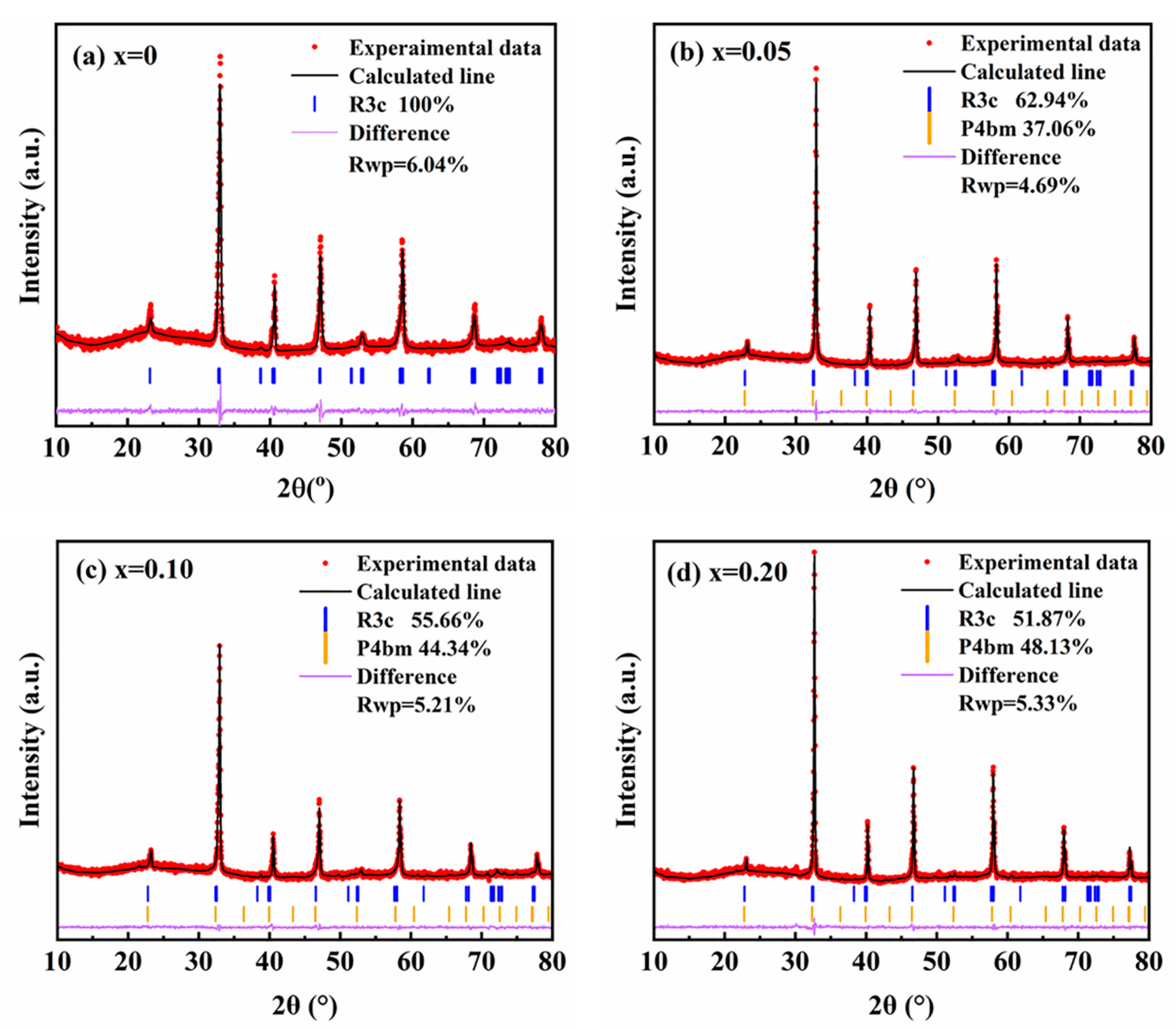
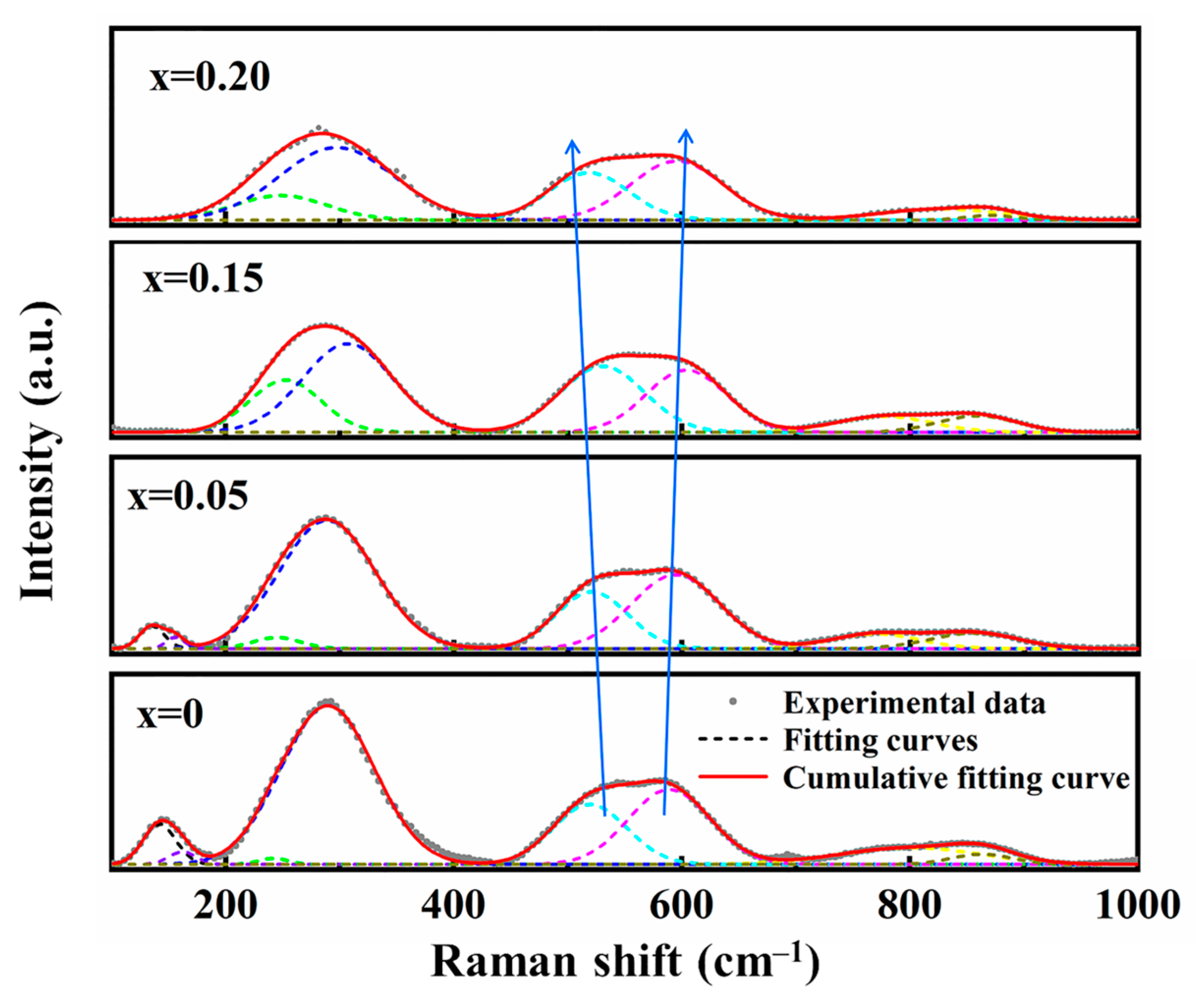


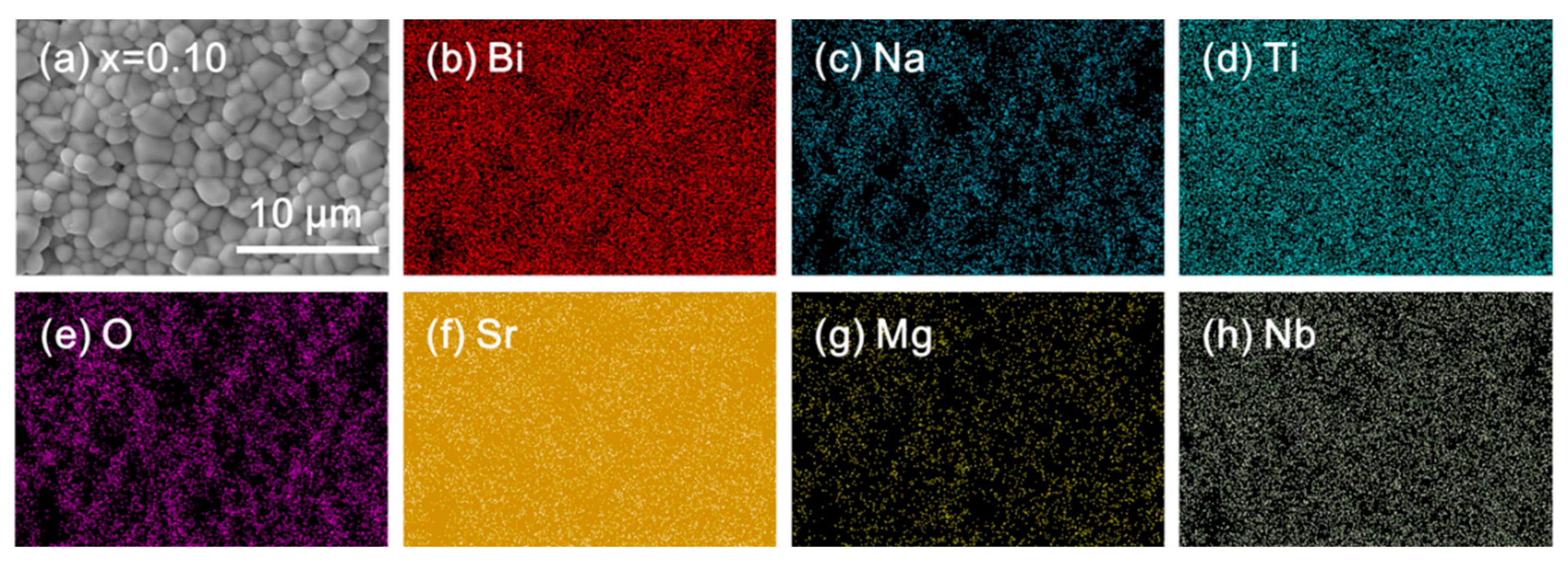
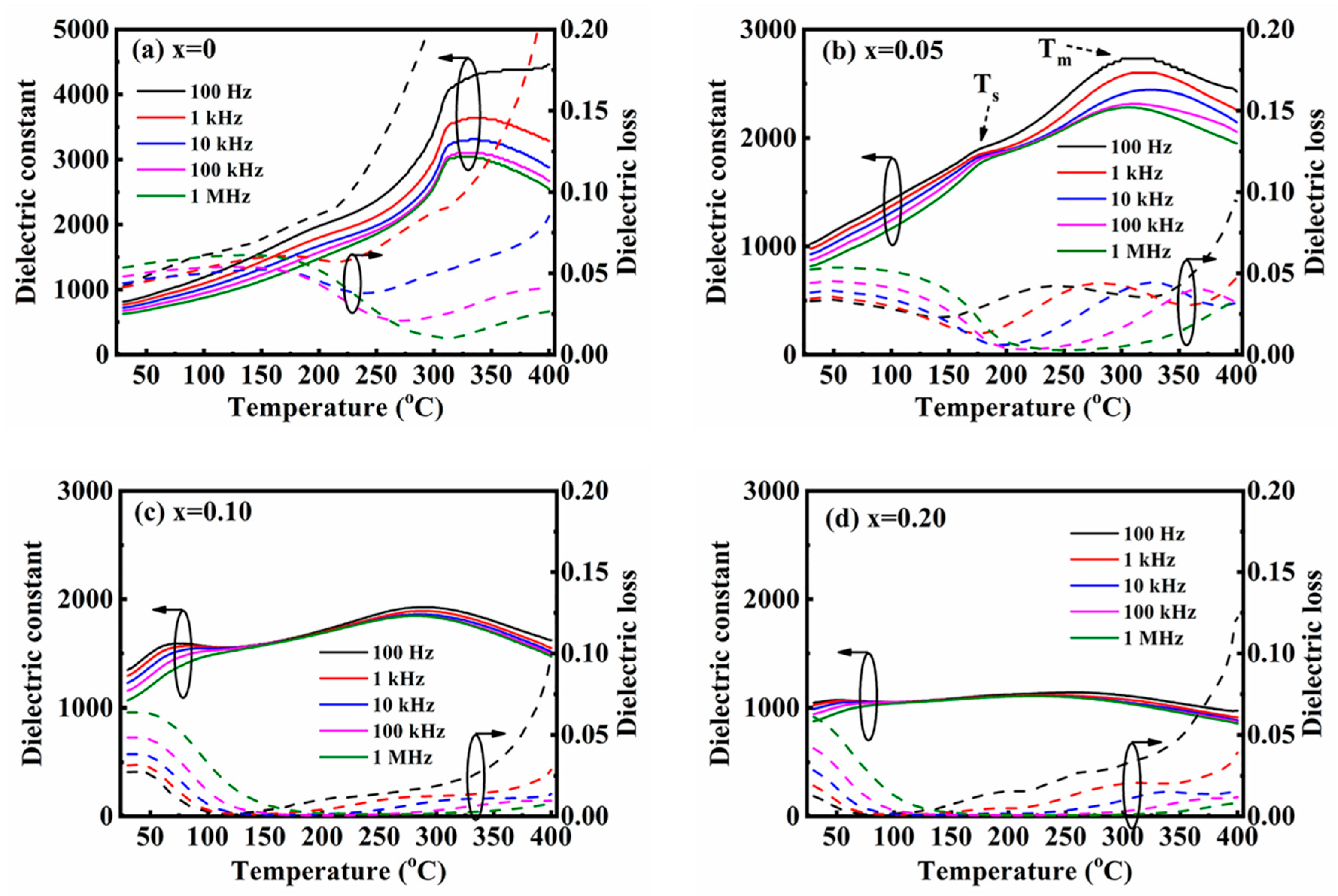


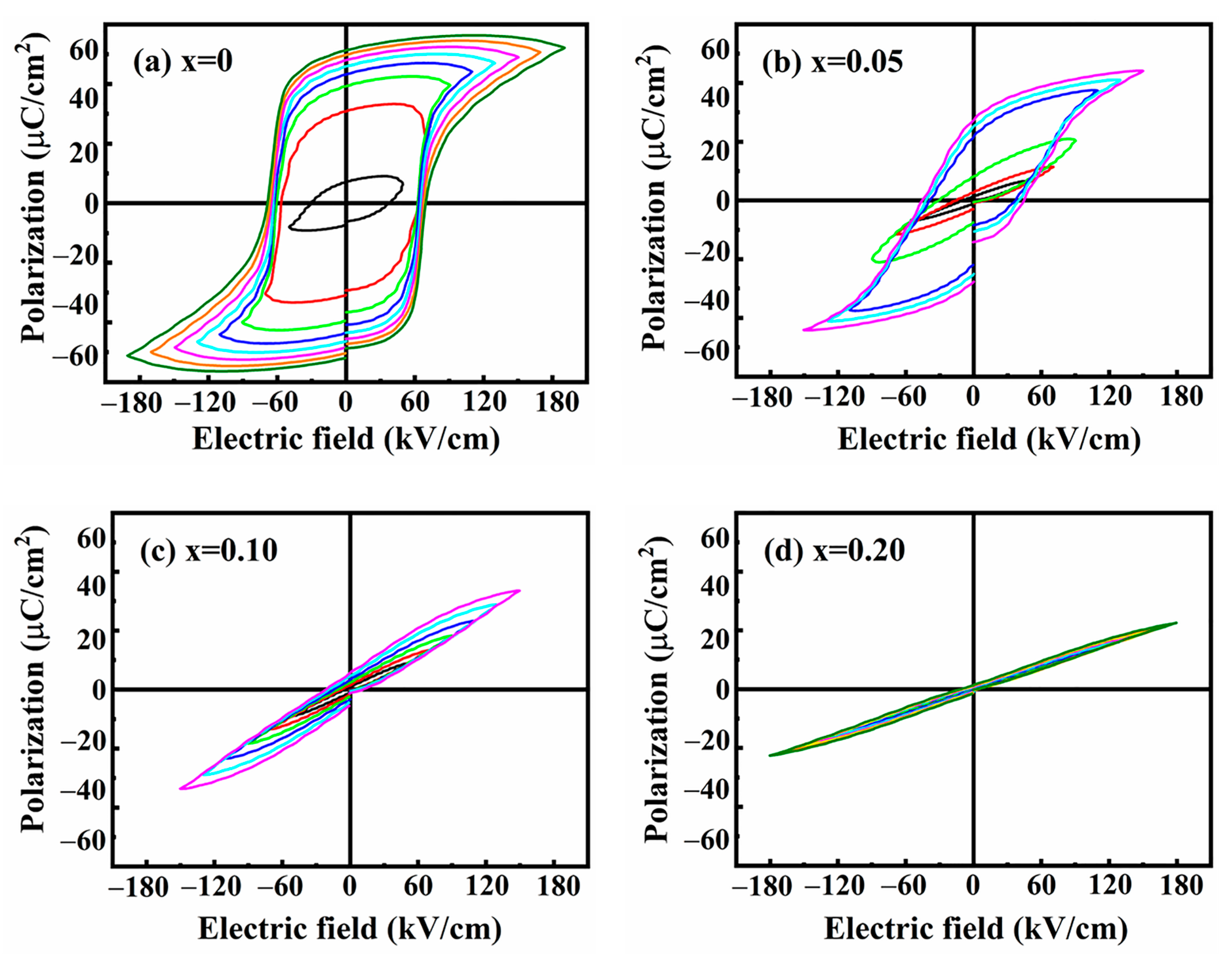
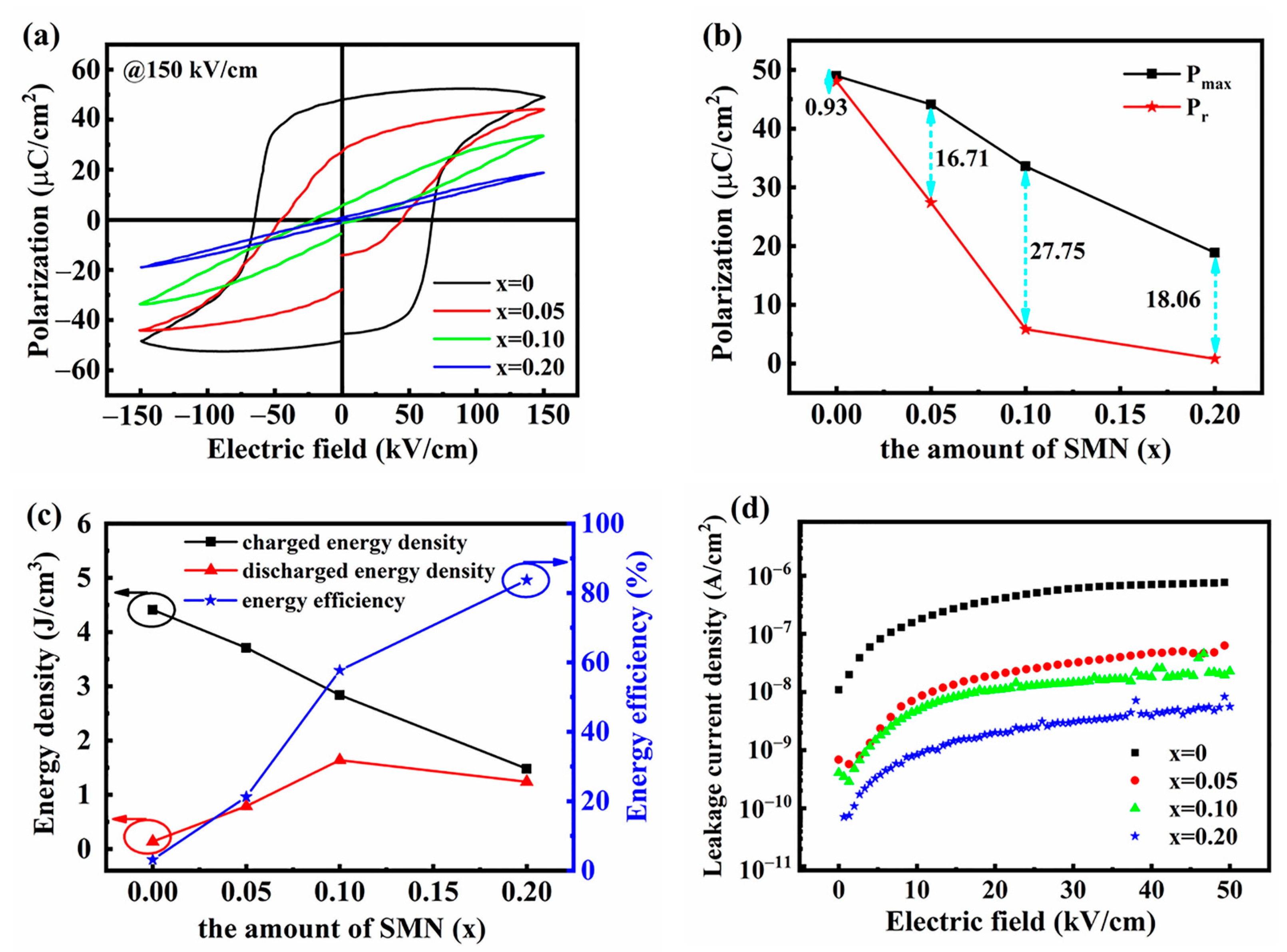
| Space Group | Weight Fraction (%) | Lattice Parameters | V (Å3) | Rwp (%) | |
|---|---|---|---|---|---|
| x = 0 | R3c | 100.00 | a = b=5.5092, c = 13.4314 | 353.0471 | 6.04 |
| α = β = 90°, γ = 120° | |||||
| x = 0.05 | R3c | 62.94 | a = b = 5.5145, c = 13.5018 | 355.5807 | 4.89 |
| α = β = 90°, γ = 120° | |||||
| P4bm | 37.06 | a = b = 5.5427, c = 3.9046 | 119.9563 | ||
| α = β = γ = 90° | |||||
| x = 0.10 | R3c | 55.66 | a = b = 5.5033, c = 13.5063 | 354.2575 | 5.21 |
| α = β = 90°, γ = 120° | |||||
| P4bm | 44.34 | a = b = 5.5027, c = 4.1839 | 126.6869 | ||
| α = β = γ = 90° | |||||
| x = 0.20 | R3c | 51.87 | a = b = 5.5347, c = 13.5676 | 359.9321 | 5.33 |
| α = β = 90°, γ = 120° | |||||
| P4bm | 48.13 | a = b = 5.5387, c = 4.1865 | 128.4293 | ||
| α = β = γ = 90° |
Disclaimer/Publisher’s Note: The statements, opinions and data contained in all publications are solely those of the individual author(s) and contributor(s) and not of MDPI and/or the editor(s). MDPI and/or the editor(s) disclaim responsibility for any injury to people or property resulting from any ideas, methods, instructions or products referred to in the content. |
© 2025 by the authors. Licensee MDPI, Basel, Switzerland. This article is an open access article distributed under the terms and conditions of the Creative Commons Attribution (CC BY) license (https://creativecommons.org/licenses/by/4.0/).
Share and Cite
Wang, Q.; Zhang, L.; Li, R.; Yang, H.; Wang, C.; Xiong, Z.; Liu, C. Insight into the Structure Evolution and Performance Optimization of Bi0.5Na0.5TiO3-Based Ceramics for Energy Storage Application. Materials 2025, 18, 1801. https://doi.org/10.3390/ma18081801
Wang Q, Zhang L, Li R, Yang H, Wang C, Xiong Z, Liu C. Insight into the Structure Evolution and Performance Optimization of Bi0.5Na0.5TiO3-Based Ceramics for Energy Storage Application. Materials. 2025; 18(8):1801. https://doi.org/10.3390/ma18081801
Chicago/Turabian StyleWang, Qian, Lin Zhang, Rui Li, Hui Yang, Chuanhui Wang, Zhao Xiong, and Chunwu Liu. 2025. "Insight into the Structure Evolution and Performance Optimization of Bi0.5Na0.5TiO3-Based Ceramics for Energy Storage Application" Materials 18, no. 8: 1801. https://doi.org/10.3390/ma18081801
APA StyleWang, Q., Zhang, L., Li, R., Yang, H., Wang, C., Xiong, Z., & Liu, C. (2025). Insight into the Structure Evolution and Performance Optimization of Bi0.5Na0.5TiO3-Based Ceramics for Energy Storage Application. Materials, 18(8), 1801. https://doi.org/10.3390/ma18081801






